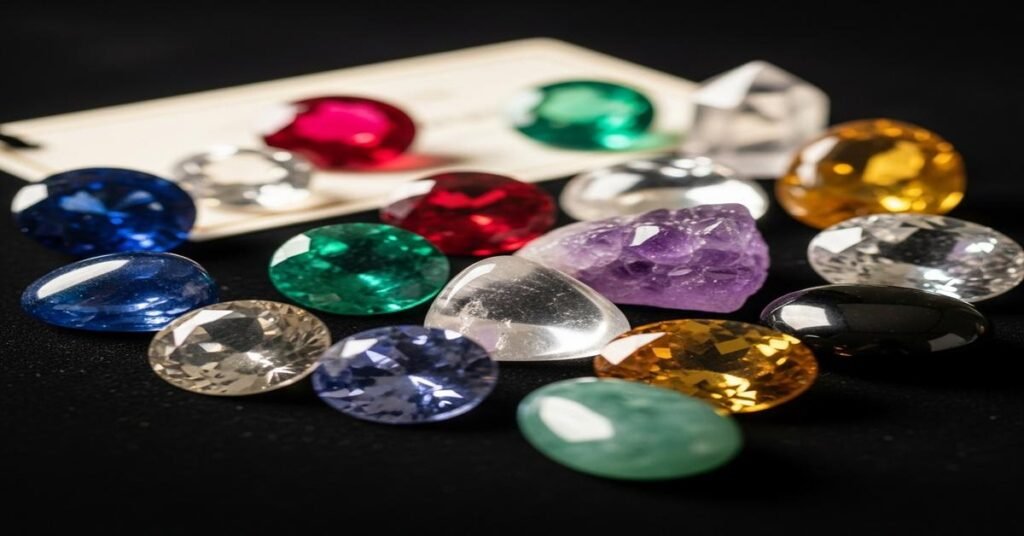Choosing a gemstone by your date of birth is more than a pretty superstition. Numerology reduces a birthdate to a single number that represents recurring themes in your life. Matching a gem to that number gives you a focused symbol to work with—color, hardness, and historical meaning all matter. This guide explains how to calculate your numerology number, offers a clear stone match for each number 1–9, and gives practical jewelry advice so your chosen gem fits your lifestyle and budget.
How to calculate your life-path (numerology) number
Reduce your full birthdate to a single digit. Add each digit of the birthdate together, then reduce until you get 1–9. Example: born 1990-06-17 → 1+9+9+0+0+6+1+7 = 33 → 3+3 = 6. Use that final digit to choose your gem. (Some numerologists keep master numbers 11, 22, 33; this guide reduces to 1–9 for clear gem pairing.)
Number-to-gem map — why these stones work
- 1 — Ruby: Ruby’s red color represents vitality and leadership. It’s corundum (Mohs 9), so it’s durable for daily rings. Choose heat‑treated rubies for affordability; untreated stones are pricier. Typical sizes: 6mm round ≈ 1.0 ct.
- 2 — Moonstone: Number 2 is partnership and intuition. Moonstone’s adularescence supports sensitivity and reflection. Mohs 6–6.5 means avoid heavy daily wear—best in pendants or bezel rings. Opt for a well‑cut cabochon, 8–12mm for visible flash.
- 3 — Citrine: Creativity and communication suit citrine (quartz, Mohs 7). It’s affordable and bright yellow to orange. Citrine is often heat-treated amethyst—disclose that. Good everyday options: 6–8mm faceted stones or 1–3 carats for pendants.
- 4 — Blue Sapphire: Stability, focus and discipline pair with sapphire. Corundum again (Mohs 9), resilient for rings and daily use. Blue enhances concentration. Expect 1 ct ≈ 6–6.5mm round. Heat treatment is common and acceptable if disclosed.
- 5 — Emerald: Change, growth and communication align with emerald’s green energy. Emeralds (beryl, Mohs 7.5–8) typically have inclusions and are often oiled to improve clarity. Use protective settings—halos, bezel or channel—to reduce chip risk. For rings, consider 0.5–1 ct; larger stones need careful wear.
- 6 — Rose Quartz (or Pink Tourmaline): Number 6 relates to love and harmony, so pink stones work well. Rose quartz is gentle (Mohs 7) and inexpensive; pink tourmaline (Mohs 7–7.5) is brighter and more durable. Choose cabochons for quartz or faceted 5–7mm for tourmaline.
- 7 — Amethyst: Spiritual insight and study match amethyst (quartz, Mohs 7). It comes in sizes from small accent stones to large statement pieces. Avoid prolonged sunlight exposure—color can fade. Typical faceted sizes: 6–10mm.
- 8 — Diamond: Manifestation, authority and material success pair with diamond. Diamond’s Mohs 10 makes it ideal for daily wear. For visible presence without excessive cost, 0.5–1 ct (round ~5–6.5mm) is a sensible range. Look for GIA/AGS reports for higher-value stones.
- 9 — Garnet: Completion and service match garnet’s deep reds and varied species (pyrope, almandine, spessartine). Hardness ranges ~6.5–7.5 depending on type. Garnets are affordable and rich in color—good for rings and pendants. Typical sizes: 5–8mm faceted.
How to pick the right setting and metal
- Durable stones (ruby, sapphire, diamond): Choose prong or bezel settings in 14k–18k gold or platinum. 14k gives better toughness for everyday wear; 18k has richer color for yellow/rose gold preferences.
- Softer stones (moonstone, rose quartz, emerald with heavy inclusions): Prefer bezels or halos that protect edges. Use 14k gold or silver for aesthetics—silver suits cool stones, rose gold complements pinks.
- Statement vs daily: For daily rings pick 0.5–1 ct or 4–7mm stones. For pendants and earrings you can go larger—12mm cabochons or 3+ ct faceted stones often work well without daily abuse.
Treatments, certification and what to ask
Most gems are treated. Heat treatment in sapphires and rubies is common and stable; emeralds are often oiled to improve clarity; citrine may be heat‑treated amethyst. Ask for clear disclosure. For stones over a few hundred dollars request a lab report (GIA, AGS, IGI are common). For diamonds, insist on grading reports for cut, color, clarity and carat. For colored gems, a report that notes treatments, origin or enhancements is valuable.
Care and maintenance
- Daily cleaning: Warm water, mild dish soap and a soft brush work for most stones. Rinse and dry thoroughly.
- Avoid: Ultrasonic cleaners for emeralds and heavily included stones; steam cleaning for oiled stones; prolonged sun for amethyst and some garnets.
- Storage: Store softer stones separately in soft pouches to avoid scratches. Diamonds and corundum can scratch other gems.
Ethics and budget tips
If provenance matters, ask sellers about traceability and ethical mining practices. Lab-grown gemstones (ruby, sapphire, diamond) offer a lower-cost, conflict‑free option with identical chemical properties. For limited budgets, choose smaller high-quality stones or use a halo and colored accent stones to increase visual impact without large carat weights.
Putting it together: a practical example
Example: birthdate 1990-06-17 → life-path 6. The guide suggests rose quartz or pink tourmaline. If you want daily wear, pick a 6mm faceted pink tourmaline in a 14k rose gold bezel ring—tourmaline is harder than rose quartz and better for rings. If you want a gentle pendant, a 12mm rose quartz cabochon on a sterling silver chain will be visible and affordable. Ask the seller about any resin fillings or surface coatings, and request return terms in case the stone’s color doesn’t match photos.
Numerology and gemstones work best together when you choose a stone that fits both the symbolic meaning and your lifestyle. Match the number’s energy, but choose the cut, size, setting and metal that let the gem live with you for years.
I am G S Sachin, a gemologist with a Diploma in Polished Diamond Grading from KGK Academy, Jaipur. I love writing about jewelry, gems, and diamonds, and I share simple, honest reviews and easy buying tips on JewellersReviews.com to help you choose pieces you’ll love with confidence.

